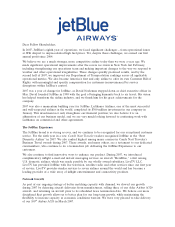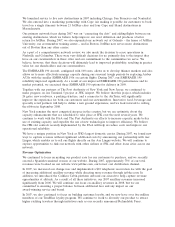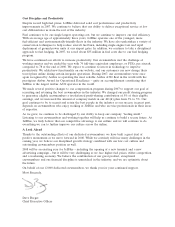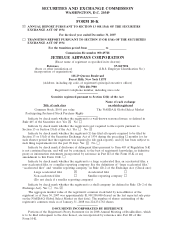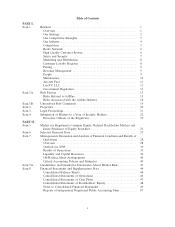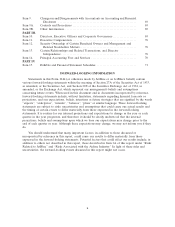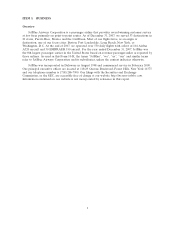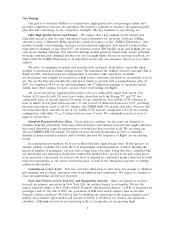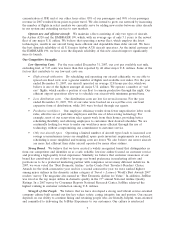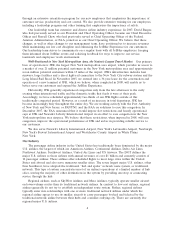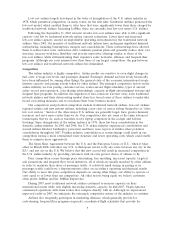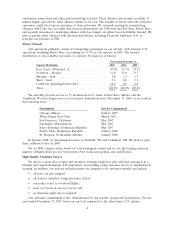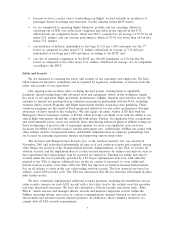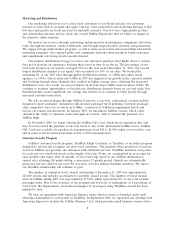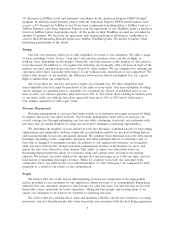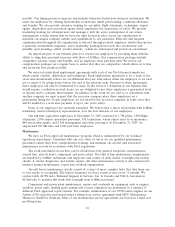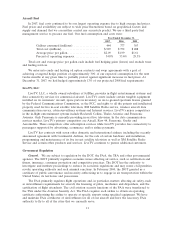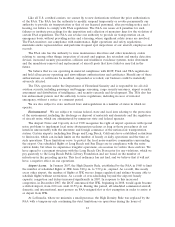JetBlue Airlines 2007 Annual Report Download - page 12
Download and view the complete annual report
Please find page 12 of the 2007 JetBlue Airlines annual report below. You can navigate through the pages in the report by either clicking on the pages listed below, or by using the keyword search tool below to find specific information within the annual report.Our Strategy
Our goal is to maintain JetBlue as an innovative, high quality, low cost passenger airline that
provides competitive fares for our customers. We intend to continue to execute a disciplined growth
plan that takes advantage of our competitive strengths. The key elements of our strategy are:
Offer High Quality Service and Product. We believe that a key element of our current and
long-term success is that we offer customers a better alternative for air travel. Onboard JetBlue,
customers enjoy a distinctive flying experience, which we refer to as the ‘‘JetBlue Experience,’’ that
includes friendly, award-winning, customer service-oriented employees, new aircraft, roomy leather
seats with 36 channels of free DirecTV®, 100 channels of free XM satellite radio and in-flight pay per
view movie channel offerings. Our onboard offerings include generous brand name snacks, premium
beverages and specially designed products for our overnight flights. Based on customer feedback, we
believe that the JetBlue Experience is an important reason why our customers choose us over other
airlines.
We strive to communicate openly and honestly with customers about delays, especially when
weather or mechanical problems disrupt service. We introduced the JetBlue Airways Customer Bill of
Rights in 2007, which provides for compensation to customers who experience avoidable
inconveniences and commits us to perform at high service standards and holds us accountable if we do
not. We are the first and currently the only major airline to provide such a comprehensive plan. In
2007, we completed 98.1%of our scheduled flights, the 9th highest percentage of any major airline.
Unlike most other airlines, we have a policy of not overbooking our flights.
All of our aircraft are equipped with leather seats in a comfortable single class layout. Our
Airbus A320 aircraft, with 150 seats, has a wider cabin than both the Boeing 737 and 757, two
comparable types of aircraft operated by many of our competitors. Our Airbus A320 cabin has at
least 36 inches of seat pitch between rows 1-11 and at least 34 inches between rows 12-25, providing
the most legroom in coach of all U.S. airlines. Our EMBRAER 190 aircraft each have 100 seats that
are wider than those currently in use in our Airbus A320 aircraft, arranged in a two-by-two seating
configuration with either 32 or 33 inches between rows of seats. We continually search for ways to
improve our product.
Stimulate Demand with Low Fares. Upon entry in a market, our low fares are designed to
stimulate demand, particularly from fare-conscious leisure and business travelers who might otherwise
have used alternative forms of transportation or would not have traveled at all. We are using our
100-seat EMBRAER 190 aircraft, for which we were the launch customer in 2005, to stimulate
demand in many mid-sized markets and to further increase the frequency of flights on our existing
routes.
In considering new markets, we focus on those that have high average fares. In this process, we
analyze publicly available data from the U.S. Department of Transportation, or DOT, showing the
historical number of passengers, capacity and average fares over time. Using this data, combined with
our knowledge and experience about how comparable markets have reacted in the past when prices
were increased or decreased, we forecast the level of demand in a particular market expected to result
from the introduction of our service and lower prices, as well as the anticipated response of existing
airlines in that market.
Commitment to Low Costs. Our low costs have allowed us to offer fares low enough to stimulate
new demand and to attract customers away from higher-priced competitors. We expect to continue to
focus on maintaining our low cost structure.
Grow Our Presence in New York City and Expand Our Network. Since our inception, we have
focused our primary operations in New York City, the nation’s largest travel market. We are the
largest domestic airline at New York’s John F. Kennedy International Airport, or JFK, as measured by
passengers and, by the end of 2007, our operations at JFK were nearly equal to that of all other
domestic airlines combined. We believe that by building our operations in the nation’s largest travel
market, more market opportunities will become available to us than if we focused our operations
elsewhere. Although an increase in connecting traffic is a byproduct of our growing flight
2



